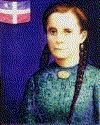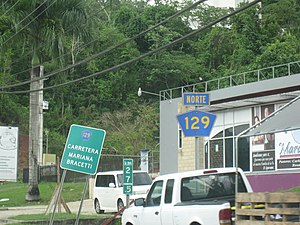Mariana Bracetti
Mariana Bracetti Cuevas | |
|---|---|
 "Brazo de Oro" (Golden Arm) | |
| Born | July 26, 1825 |
| Died | February 25, 1903 (age 77) |
| Occupation | Puerto Rico independence movement leader |
| Spouse | Miguel Rojas |
Mariana Bracetti Cuevas (also spelled Bracety) (July 26, 1825 – February 25, 1903) was a patriot and leader of the Puerto Rico independence movement. In 1868, she knitted the Grito de Lares flag that was intended to be used as the national emblem of Puerto Rico in its first of two attempts to overthrow Spanish rule, and to establish the island as a sovereign republic. As the flag of the Grito de Lares revolt, Bracetti's creation became known as the Bandera del Grito de Lares (Grito de Lares flag), most commonly known as the Bandera de Lares (Lares flag). Today, the flag is the official flag of the municipality of Lares, Puerto Rico.[1]
Early years
[edit]Bracetti, born in the city of Añasco, Puerto Rico, met and developed a romantic relationship with Miguel Rojas Luzardo, a rich Venezuelan businessman visiting Añasco. Rojas and his brother Manuel owned a coffee plantation called "El Triunfo" near Lares. Miguel and Manuel Rojas were admirers of Dr. Ramón Emeterio Betances and were influenced by his ideals of independence for and beyond Puerto Rico. Bracetti married Rojas with whom she had children.[2]
The first independence movement flag of Puerto Rico
[edit]Bracetti then moved to the hacienda "El Triunfo", which was to become the clandestine nucleus of the revolution that would be known as El Grito de Lares. The Rojas' admiration for Betances led them to join him in the conspiracy to rebel against, and gain independence from, Spain.
| ||||||
The Rojas brothers became the independence leaders in Lares and their code name was Centro Bravo (Bravo Center). Manuel Rojas, Bracetti's brother-in-law, was named Commander of the Liberation Army. Mathias Brugman was the independence leader in Mayagüez and his group went by the code name of Capa Prieto (Dark Cape).
Bracetti's nickname was Brazo de Oro (Golden Arm) and she was appointed the leader of the "Lares's Revolutionary Council." Betances suggested that Bracetti knit the first flag (modeled on the Dominican Republic's flag) of the future "Republic of Puerto Rico." With the materials provided by Eduvigis Beauchamp Sterling, named Treasurer of the revolution by Betances,[3] Bracetti designed and knitted the flag taking into consideration Betances's suggestions. The flag was divided in the middle by a white Latin cross, the two lower corners are red and the two upper corners are blue. A white star was placed in the upper left blue corner.[4] According to Puerto Rican poet Luis Lloréns Torres the white cross on the Revolutionary Flag of Lares stands for the yearning for homeland redemption; the red squares, the blood poured by the heroes of the rebellion and the white star in the blue solitude square, stands for liberty and freedom.[5]
El Grito de Lares
[edit]On the morning of September 23, 1868, an Army of about 800 men met in the El Triunfo plantation and Manuel Rojas proceeded to take the town of Lares, which initiated the revolution known as El Grito de Lares. Once the town was taken, Bracetti's flag was placed on the High Altar of the Parroquial Church. The revolutionists declared Puerto Rico a republic, swore in Francisco Ramírez Medina as its first president and celebrated a speedy mass.
The rebel forces then departed to take over the next town, San Sebastián del Pepino. The Spanish militia, however, surprised the group with strong resistance, causing great confusion among the armed rebels who, led by Manuel Rojas, retreated back to Lares. Upon an order from the governor, Julián Pavía, the Spanish militia soon rounded up the rebels. All of the survivors, including Bracetti, were imprisoned in Arecibo and the insurrection was quickly brought to an end. The original Lares flag was taken by a Spanish army officer as a war prize and many years later returned to the Puerto Rican people. It is now exhibited in the University of Puerto Rico's Museum.[6] Eighty of the prisoners died in jail, Bracetti however, lived and was released on January 20, 1869, when the new Spanish Republican government granted them general amnesty.[7] Mariana Bracetti died in the municipality of Añasco, Puerto Rico in 1903 and was buried in the Plaza of Añasco. There is a monument honoring her on the spot where she is buried.
Legacy
[edit]Juan de Mata Terreforte, a revolutionist who fought alongside Manuel Rojas in the Grito de Lares, and who was the Vice-President of Puerto Rican Revolutionary Committee, a Chapter of the Cuban Revolutionary Party in New York City,[8] adopted Bracetti's "Flag of Lares" as the flag which represented Puerto Rico. It became their standard until 1892 when the current design, modeled after the Cuban flag, was unveiled and adopted by the committee.
Bracetti was the principal subject of two books: El Grito de Lares by Luis Lloréns Torres, and Brazo de Oro by Cesáreo Rosa-Nieves.[4] Her memory has been honored in Puerto Rico and elsewhere[9] with schools, streets and avenues named after her. In Lares, there is a Mariana Bracetti Museum[10] and in Philadelphia there is a Mariana Bracetti Academy Charter School.[11] The Mariana Bracetti Plaza and public housing development in New York City was also named after her. The public housing development built and maintained by the New York City Housing Authority in New York City's Lower East Side.[12]
-
Statue of Mariana Bracety Cuevas in Añasco barrio-pueblo
-
Puerto Rico Highway 129 is also called Carretera Mariana Bracetti near km 27.5 in Lares, Puerto Rico
See also
[edit]19th century female leaders of the Puerto Rican independence movement
Female members of the Puerto Rican Nationalist Party
- Blanca Canales
- Rosa Collazo
- Lolita Lebrón
- Ruth Mary Reynolds
- Isabel Rosado
- Isabel Freire de Matos
- Isolina Rondón
- Olga Viscal Garriga
Articles related to the Puerto Rican Independence Movement
- Puerto Rican Nationalist Party Revolts of the 1950s
- Puerto Rican Nationalist Party
- Ponce massacre
- Río Piedras massacre
- Puerto Rican Independence Party
- Grito de Lares
- Intentona de Yauco
References
[edit]- ^ Mariana Bracety Cuevas (DVD video, 2009). OCLC 649394917. Retrieved 2020-07-23 – via WorldCat.org.
- ^ Fundación Héctor A. García; Poryecto Salón Hogar. Mariana Bracetti. Retrieved on September 26, 2007.
- ^ "Beauchamp family". Archived from the original on 2016-06-04. Retrieved 2012-01-24.
- ^ a b Puerto Rican Women/Mujeres Puertorriqueñas; By Carmen D. Votaw (author), Michelle Sague (editor), and Pat Barton (illustrator); ISBN 0-9650649-0-5
- ^ Lares
- ^ The First Puerto Rican Flag
- ^ Madrinas to us all: Significant Latinas in history Archived 2009-03-02 at the Wayback Machine
- ^ Enciclopedia de Puerto Rico Archived 2015-09-24 at the Wayback Machine
- ^ Mariana Bracetti Academy Charter School in Philadelphia, Pennsylvania
- ^ Museo Mariana Bracetti
- ^ Mariana Bracetti Academy Charter School.
- ^ New York City Housing Authority Archived 2009-12-04 at the Wayback Machine
Further reading
[edit]- Puerto Rican Women/Mujeres Puertorriqueñas (Paperback). By Carmen Delgado Votaw (author), Michelle Sague (editor), and Pat Barton (illustrator); ISBN 0-9650649-0-5
- Mariana Bracety : una patriota que no claudicó (Book, 2016). OCLC 960373581. Retrieved 2020-07-23 – via WorldCat.org.
- 1825 births
- 1903 deaths
- Flag designers
- People from Añasco, Puerto Rico
- Puerto Rican people of Corsican descent
- Puerto Rican rebels
- Puerto Rican women in politics
- Puerto Rican women in the military
- Imprisoned Puerto Rican independence activists
- 19th-century Puerto Rican people
- Female revolutionaries
- 19th-century Puerto Rican women



